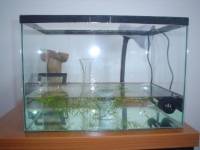10 tips for a successful Betta splendens reproduction
Short info
Brief Description
This article describes 10 simple tips that make breeding Betta fish easy and more successful. However you should also visit the following pages too since they contain other information about breeding and raising this species: Breeding Betta Fish in Fish Tanks with plenty of experiences/posts, Siamese fighting fish (Betta splendens) profile with huge forum, Betta fish care, FAQ, pictures and caring for Bettas, Diseases of Betta fish. We'd also love to hear about your Siamese fighting fish! Use a form at the bottom of this page for sharing your experiences!

Betta splendens is one of the most wanted fish in everyone’s aquarium. Breeding Bettas is not hard, though you might face problems at spawning them. They are oviparous fish, the male builds a nest in which the eggs/fry are kept for few days under the strict care of the Betta male. If you follow the next advices, you have big chances to get nice results of your Betta fish spawning.
- Reproduction tank equipment: volume of 15-20 litres, a heater, a thermometer and air pump connected to an air rock which will spread small bubbles. You need small bubbles because the fry are very sensitive to water movements and you don’t want them to suffer.
- The aquarium water must have a temperature of 28-29° C, a higher temperature will hurry the eggs hatching and the fry won’t be fully developed. Keep the temperature constant using the heater and check it with the thermometer to make sure it is at the right level.
- The water depth must not exceed 10-15 cm because the Betta eggs are denser than water and they fall down from the nest. The male picks them up in its mouth and brings them back in the bubble nest, but a water column over 15 cm will tire it after few repetitions.
- Cover the reproduction aquarium with a lid in order to keep the same temperature for the air inside the aquarium. The fry develop their labyrinth after about 30 days and they are very sensitive to temperature changes. The lid also protects against air flow which could ruin the bubble nest.
 Select a compatible pair of Bettas. At first attempts you’ll only want to get some fry and you won’t be interested in colors/fins, but after some successful spawns you’ll be more pretentious. So you’ll chose same colored Bettas or even more, you’ll look for developing some nice fins (double tails, crown tails, half moons, etc.) but this is another discussion...
Select a compatible pair of Bettas. At first attempts you’ll only want to get some fry and you won’t be interested in colors/fins, but after some successful spawns you’ll be more pretentious. So you’ll chose same colored Bettas or even more, you’ll look for developing some nice fins (double tails, crown tails, half moons, etc.) but this is another discussion...- Introduce the male in the evening and only next morning introduce the female, considering that the male has already built the bubble nest. During the night keep the female in a jar near the aquarium and assure some light in order to make eye contact between the male and female; this will stimulate the bubble nest building.
- The next day, after introducing the female, the Betta male will brutally chase her. That’s why you have to put some plants in the corners of the aquarium in order to assure hiding places for the female. Also make sure you add some floating plants in order to help the bubble nest building.
- After the first successful egg evacuation, the male (sometimes the female too) will take them (in the mouth) from the bottom of the aquarium and bring up in the bubble nest. You don’t have to panic because this is a natural thing, so don’t take the fish out thinking they eat their eggs ;)
 A good pair of Bettas can spawn up to 400-500 eggs, after which the female has to be taken out from the aquarium because the male will brutalize her in order to protect the nest. Put the female, for a few hours, in a jar with water where you added some methylene blue in order to prevent eventually infections caused by the wounds.
A good pair of Bettas can spawn up to 400-500 eggs, after which the female has to be taken out from the aquarium because the male will brutalize her in order to protect the nest. Put the female, for a few hours, in a jar with water where you added some methylene blue in order to prevent eventually infections caused by the wounds.- After about 48 hours the fry will hatch and the Betta male will assure they stay together in the bubble nest. After another 2-3 days the fry will swim free. Now it’s time to take out the male and start feeding them with Paramecium and/or Artemia salina (Baby Brine Shrimp).
This is it ;) 10 tips for a successful Betta splendens reproduction. You can find advanced information on specialized websites, books, etc, but following this article should familiarize you with the Betta splendens reproduction needs.
Author bio: Laurentiu Craciunas has been breeding Betta splendens for over 5-6 years now and he wants to share his experience with others too. You can read more aquaria related articles on his website: Tropical Fish Aquariums.
